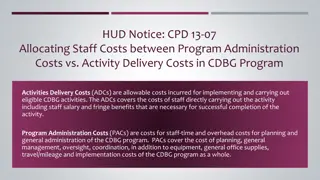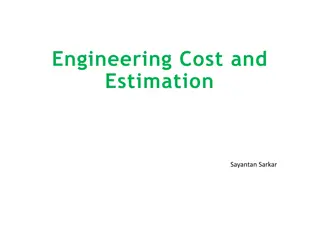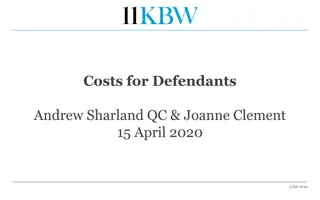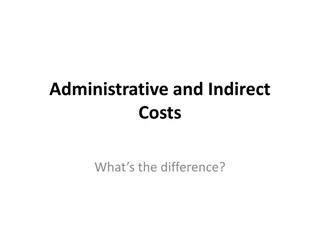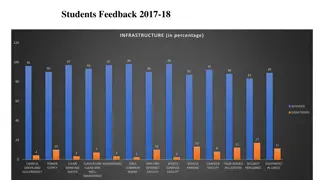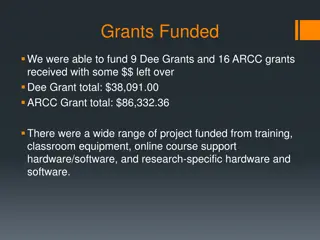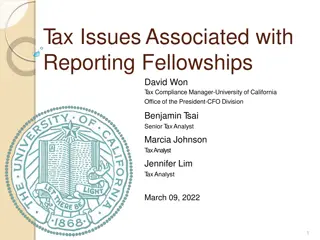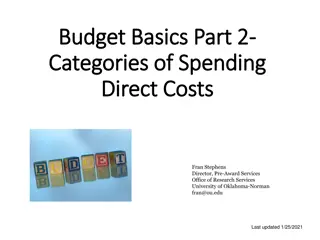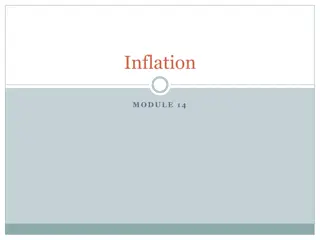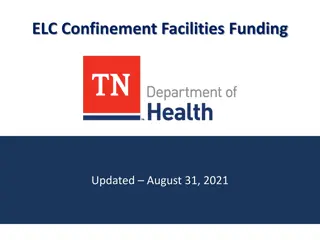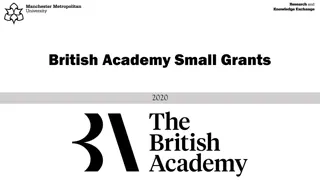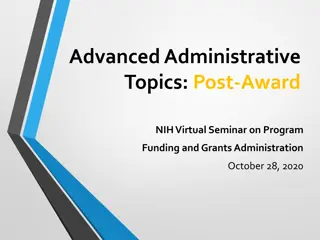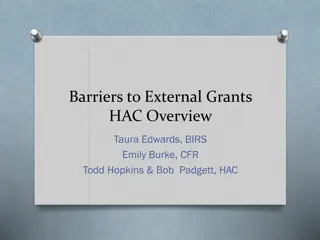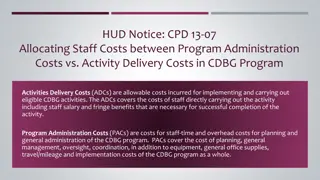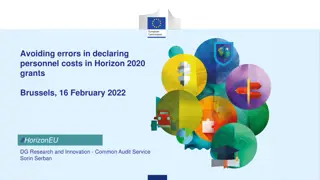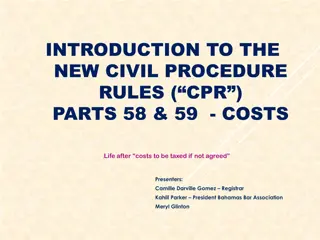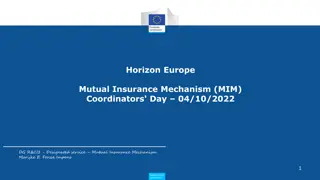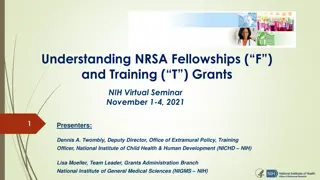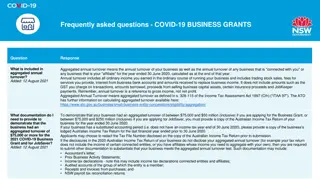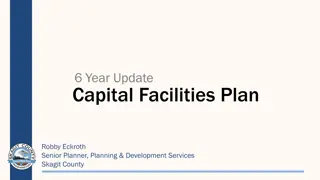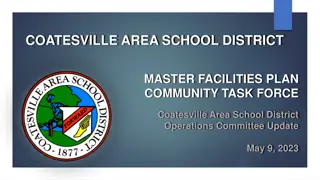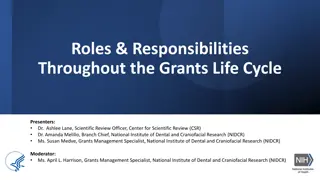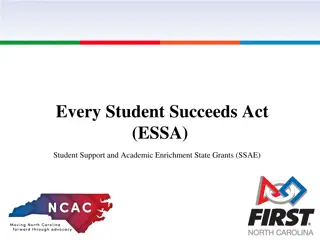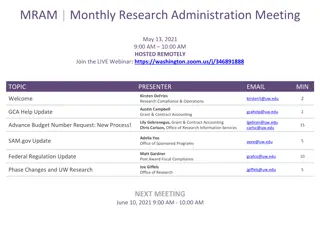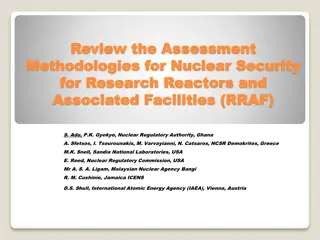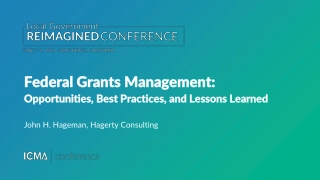Understanding Facilities and Administration (F&A) Costs in Research Grants
Universities have a long history of partnering with the federal government in conducting research. This partnership incurs various costs known as Facilities and Administration (F&A) costs, which cover infrastructure, administrative, and compliance expenses. F&A costs are essential for supporting research activities and ensuring accountability in federal research grants.
Download Presentation

Please find below an Image/Link to download the presentation.
The content on the website is provided AS IS for your information and personal use only. It may not be sold, licensed, or shared on other websites without obtaining consent from the author. Download presentation by click this link. If you encounter any issues during the download, it is possible that the publisher has removed the file from their server.
E N D
Presentation Transcript
History of F&A Universities and the federal government have a long-standing and successful partnership that grew out of World War II. The federal government relies on universities to conduct research in the Nation s interest. Health and Welfare Economic Growth National Defense Performing research on behalf of federal agencies incurs a variety of costs that would not otherwise exist for universities. Universities not the federal government assume the risk of building the necessary infrastructure to support this research. Universities are anticipating that their research faculty will successfully compete for federal research grants. Awarded university will be reimbursed for a part of the associated infrastructure costs.
Federal Funding for Research Direct costs personnel, supplies, equipment and travel Facilities and administrative costs - the cost of research facilities including debt to build buildings and maintenance, compliance, and the administration of a grant throughout its lifecycle. These costs cannot be viewed separately; together they represent the total cost of performing research.
What are Facilities and Administration (F&A) Costs F&A is also referred to as follows: Indirect Costs (IDC) Overhead Indirect Cost Recovery (ICR) Operating Costs
What are Facilities and Administration (F&A) Costs F&A costs are those research operating costs incurred by all awards. Research institutions provide the physical space where research is conducted. Construction and maintenance of advanced research facilities and the resources necessary to conduct research. Debt to build research buildings Building maintenance Utilities Internet/Data storage Libraries Housing for research animals Hazardous waste disposal Insurance/Security Human Resources Accounting Other compliance and oversight activities
Administrative and Compliance Costs Financial management, billing, letter of credit draws Accountability for research time charged to federal awards (ePERS) Procurement and Accounts Payable activities Management of grant budgets and financial reporting Human protection programs and institutional review boards for human subjects research institutional animal care and use programs for animal research Radiation and chemical safety and biosecurity Implementing and tracking federally required training and education Conflict of Interest oversight and management Export controls oversight and management Ensuring timely and accurate reporting of research progress; Financial closeout The institution, as the grantee, takes on the responsibility and risk of a grant, and provides both the facilities and compliance support necessary for the investigator to conduct research.
How Does F&A Work The Federal government funds only that portion of F&A costs, including the costs of research space, incurred in conducting federal research. The mechanism for reimbursement is a negotiated F&A rate between the federal government and each individual research institution to ensure appropriate costs. To prevent inequity to federal sponsors when non-federal sponsors impose limitations on F&A reimbursement, OMB rules require that a university calculate its F&A rate by allocating F&A costs across all research, not just federally-sponsored research. Single research F&A rate Cost of conducting all sponsored research Ensures that the federal government does not subsidize the F&A costs for research sponsored by private foundations and charitable organizations
Additional F&A Facts The administration portion of an institution s negotiated rate is capped at 26%. Irrespective of the institution's actual administration costs for sponsored research With this cap, the University s full administrative costs is not covered Reason the off campus rate is 26% According to federal data, institutions own funds now constitute more than 24% of higher education research & development (R&D) activities. $16.7 billion in FY15 $4.8 billion in the form of unreimbursed F&A Over $1.3 billion in cost sharing Federal spending on higher education R&D was just under $37.9 billion in FY 2015, or 55% of R&D.
University of Colorado Denver|Anschutz Medical Campus Federally Negotiated F&A Rate On-Campus on basis of Modified Total Direct Cost (MTDC) 55.5% Organized research 42% Instruction 26% Public service/other activity Off-Campus on basis of Modified Total Direct Cost (MTDC) 26% For all types of activities
Research Types Organized Research - Research and scholarship activities include the rigorous inquiry, experiment or investigation to increase the scholarly understanding of the involved discipline. Instruction - Sponsored instruction and training means specific instructional or training activity established by grant, contract, or cooperative agreement. Does not include research training. Other Sponsored Activities - All other activities, programs and projects financed by Federal and non-Federal agencies and organizations which involve the performance of work other than sponsored research or instruction. Editorships Conferences Travel Awards Health Service Projects Community Service Programs
On Campus Vs Off Campus On Campus More than 50% of the work takes place at an on campus location. On Campus List Off Campus More than 50% of the work takes place at an off campus location. Off Campus List Location is most likely off campus if not listed.
University of Colorado Denver|Anschutz Medical Campus Federally Negotiated F&A Rate Modified Total Direct Cost (MTDC) means certain expenses are exempt from F&A including -- Subcontract expenses over $25,000 Equipment over $5,000 Patient care Scholarships/tuition
Industry Clinical Trials Private Pharmaceutical/private for-profit companies F&A - 28% on total direct expenses all expenses including patient care Majority of patient care is occurring in hospital
Industry Clinical Trials Definition Use NIH definition of clinical trial -- A research study in which one or more human subjects are prospectively assigned to one or more interventions (which may include placebo or other control) to evaluate the effects of those interventions on health-related biomedical or behavioral outcomes. A "health-related biomedical or behavioral outcome" is defined as the pre-specified goal(s) or condition(s) that reflect the effect of one or more interventions on human subjects biomedical or behavioral status or quality of life.
Industry Clinical Trials Definition Examples include: Positive or negative changes to physiological or biological parameters (e.g., improvement of lung capacity, gene expression); Positive or negative changes to psychological or neurodevelopmental parameters (e.g., mood management intervention for smokers; reading comprehension and /or information retention); Positive or negative changes to disease processes; Positive or negative changes to health-related behaviors; and Positive or negative changes to quality of life
Industry Clinical Trials Definition The FDA has two definitions of a clinical trial depending on whether the item under investigation is a drug or device: Clinical investigation means any experiment in which a drug is administered or dispensed to, or used involving, one or more human subjects. For the purposes of this part, an experiment is any use of a drug except for the use of a marketed drug in the course of medical practice. Investigation means a clinical investigation or research involving one or more subjects to determine the safety or effectiveness of a device.
Examples of research that would not be considered a clinical trial Human subjects research that would not meet the definition of a clinical trial would be clinical research Not subject to FDA oversight NIH funded research that is limited to data collection Other human subjects research that may collect data and/or specimens and is intended to provide material for work on various research questions
Private companies research (non-clinical trials) July 2017 changed the F&A charged to private companies to be more aligned with other Universities practice and equitable with federal government. Approval by Dean Reilly, VC Research Dr. Traystman, Chancellor Elliman and Executive VC Administration & Finance | CFO, Terri Carrothers Presented at SOM Executive meeting as well as other forums including SOM Administrators Research/ sponsored funding with private companies (not clinical trials) require the budget to include the appropriate federally negotiated F&A rate.
Private companies research (non-clinical trials) Equitable treatment between federal gov t and private companies Federal government has concerns if other sponsors are paying less than federal gov t Examples of Universities charging private companies at their federal F&A rate Oregon Health Sciences University University of North Carolina University of California San Francisco University of Minnesota University of Nebraska (require on TDC not MTDC) The University of Alabama at Birmingham
Private companies research (non-clinical trials) Examples of Universities charging private companies more than their federal F&A rate Johns Hopkins University 72%, 8.25% higher than federal, on TDC Northwestern University 69.64%, 11.64% higher than federal University of Pittsburgh 61.5%, 5% higher than federal
Private Industry Sponsored Research Any variance in the rate requires a waiver. Must be submitted through respective Dean s office first Must be well justified Approval rate is low On Campus = 55.5% Off Campus = 26% Waiver must be submitted even if: There is a published rate in the FOA/RFP, there is a rate published in a policy, Or the sponsor provides an email/letter stating a rate that varies CU Denver | AMC F&A Policy
Private Industry Clinical Trial Any variance in the rate requires a waiver. Must be submitted through respective Dean s office first Must be well justified Approval rate is low On Campus = 28% Off Campus = 28% Waiver must be submitted even if: There is a published rate in the FOA/RFP, there is a rate published in a policy, Or the sponsor provides an email/letter stating a rate that varies CU Denver | AMC F&A Policy
Any variation from the institution F&A rate or sponsor published F&A requires a waiver. Must be submitted through respective Dean s office first Must be well justified Approval rate is low Federal / State Agreements Exceptions: Sponsor consistently applied published policy Indirect cost rate is listed in the RFP/FOA A letter or email from an official of the sponsor noting the F&A rate for the opportunity will suffice in place of a waiver (These instances should be verified with the PreAward or Contracts Manager). No clear indication of an F&A rate is published on the sponsor website or within the funding announcement. On Campus = 55.5% Off Campus = 26%
Any variation from the institution F&A rate or sponsor published F&A requires a waiver. Must be submitted through respective Dean s office first Must be well justified Approval rate is low Non-Profit Foundations and Associations Sponsor consistently applied policy or: Exceptions: Sponsor consistently applied published policy Indirect cost rate is listed in the RFP/FOA A letter or email from an official of the sponsor noting the F&A rate for the opportunity will suffice in place of a waiver (These instances should be verified with the PreAward or Contracts Manager). No clear indication of an F&A rate is published on the sponsor website or within the funding announcement. 10% de minimus rate if no policy
Precedence of Compliance - NCURA Various regulations complement one another to guide the implementation of awards.



